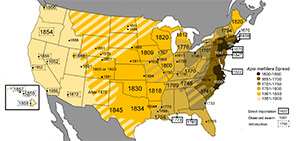
The genealogy of honey bees in the United States.
The Western honey bee, Apis mellifera, is not native to the United States. Most beekeepers know this.
But do you know the genealogy of A. mellifera (hereafter, the “honey bee”) in the United States? In other words, do you know the full story of when honey bees came to the USA, how many times they were introduced, where each of those introductions occurred, how quickly they spread from one part of our country to another, and which lineages are most abundant in your neighborhood as a result of this history? These are the topics for our fortieth Notes from the Lab, where we summarize “Genetic past, present, and future of the honey bee (Apis mellifera) in the United States of America,” written by Madeline Carpenter and Brock Harpur and published in Apidologie [2021].
More than 25 million people have used 23andMe, Ancestry.com, or other genetic tests to trace their genealogies. Many of us are clearly curious about where our great-great-great-grandparents came from! Similarly, I can assure you from talking with hundreds of beekeepers over the years that every single one of us is interested in the genealogy of our bees.
Some beekeepers are simply curious to know the lineage of their bees. Do I have Italian bees? Are my bees Carniolans? But many beekeepers also know that specific traits, such as varroa resistance, have a genetic basis (e.g., Purdue “mite biting” bees). This means that the pedigree of your bees matters since those genes are passed down from the previous generation. In other words, knowing the genetics and genealogy of honey bees can help us understand their history, but it can also allow us to understand their future in terms of the diversity of traits that can be improved through breeding.
For their study, Carpenter and Harpur tapped into two major resources. First, they did some good old-fashioned work in the library. Because honey bees have been intensively managed for nearly 11,000 years, we humans have been pretty good about noticing them and writing down our observations. So, if you want to know when and where honey bees were present, you can read old documents to see when and where someone mentions them in historical records. The authors pored over thousands of documents, ultimately finding nearly 200 records that indicated the first time honey bees were observed in a particular geographic location in the USA.
Second, nearly two dozen honey bee population genetic studies have been conducted in the United States to date, and more studies are in the works. Carpenter and Harpur summarized all existing scientific literature on this topic. Ultimately, these genetic studies allow us to understand how introductions of various lineages have shaped the genetic diversity and differentiation of honey bee populations across the USA. It is this diversity and differentiation that provides the raw material necessary for breeding.
So, when and where were honey bees first introduced to the United States? 1622 in Jamestown, Virginia (see Figure 1). If you’re sitting in Virginia right now and reading this article, you’re sitting in the region that’s enjoyed the longest history of honey bees in the USA, starting with the first introduction by the Virginia Company from England.
Three other locations were relatively quick to follow. Honey bees were introduced by English colonists to Plymouth and Boston, Massachusetts in 1637 and 1640, respectively, and by English colonists to Long Island, New York in 1670 (Figure 1). Between 1670 and 1845, only two additional importation records exist; Pensacola, Florida in 1763, and Mobile, Alabama in 1773.
During this time, honey bees spread west to the Mississippi by two mechanisms: trade among humans and natural swarming. For example, in the 1700s, it was common for “bee trees” to be found throughout the Carolinas and Pennsylvania. Then, in the mid-1800s, importations started to pick up in the western United States. In 1845, honey bees were imported to Texas by German settlers, and numerous introductions occurred on the west coast (California, Oregon, Washington) and Hawaii in the 1850s (Figure 1).
Which lineages were introduced? At least nine subspecies from four of the five A. mellifera lineages have been introduced to the USA. But for over 200 years (between 1622 and 1859), the only honey bee subspecies present in the United States was A.m. mellifera (Apis mellifera mellifera). Bees from this lineage (lineage M) come from northern Europe and central Asia and include the English “dark bees,” which were the first honey bees to arrive in Jamestown.
Italian bees (A.m. ligustica; lineage C, from central and southern Europe) were the next to arrive, imported in 1859 to New York City and Philadelphia from Germany and Switzerland (Figure 2, red square). In the 1860s, Italian queens were imported to several locations in the USA from the Lake Maggiore region of northern Italy, until it became more common in the 1890s to import from Milan and Bologna.
Carniolan bees (A.m. carnica; lineage C) were first imported in 1877 to Hamilton, IL (Figure 2, red circle) by none other than Charles Dadant, the founder of Dadant & Sons, which publishes the fine magazine you’re currently reading. Carniolan bees were imported throughout the ….


